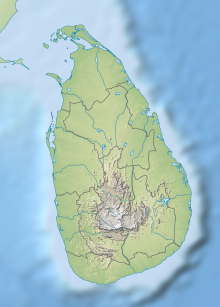Elephant pass
Location of the elephant pass in Sri Lanka |
The Elephant Pass ( English : Elephant Pass , Tamil : ஆனையிறவு Āṉaiyiṟavu [ aːnɛi̯jirəʋɯ ] Sinhala : අලිමංකඩ Alimaṅkaḍa [ alimaŋkəɖə ]) is the connection between the Jaffna peninsula and the Vanni region in the north of Sri Lanka . The most important traffic connections to Jaffna , the capital of the northern province , lead over the elephant pass. During the civil war in Sri Lanka (1983-2009) the elephant pass was contested several times because of its strategic importance.
geography
The Elephant Pass is located in the north of Sri Lanka between the Jaffna Peninsula and the main island. It separates the Jaffna lagoon in the west from the Chundikkulam lagoon in the east. Originally, the two lagoons formed a uniform body of water, which reached its narrowest point at the Elephant Pass at around 1000 meters. Here the water was so shallow that elephants could flow through it before the road was built. The elephant pass owes its name to this fact.
Today an artificially raised dam leads over the elephant pass. The highway A9 to Jaffna passes this place. Until the completion of the Sangupiddy Bridge further west in 2011, the Elephant Pass was the only access to the Jaffna Peninsula. The railway line to Jaffna also runs over the elephant pass. After an interruption of 14 years due to the war, the railway line has been in operation again since 2014.
The Elephant Pass is 54 kilometers from Jaffna and 20 kilometers from Kilinochchi . Administratively it belongs to the Kilinochchi District of the Northern Province.
history
In 1776 the Dutch , who ruled Sri Lanka at the time, built a fort on the north side of the Elephant Pass. The fort was later converted into a guesthouse and destroyed in the civil war. After independence, the army set up a base on the Elephant Pass to control the smuggling of wood.
During the civil war in Sri Lanka (1983-2009) the elephant pass was contested several times because of its strategic importance. In July – August 1991 the rebels of the Liberation Tigers of Tamil Eelam (LTTE) failed in their attempt to seize the elephant passport held by the Sri Lankan army . The army expanded the elephant pass into a base that temporarily housed an entire division and used it as a springboard for their operations on the Jaffna Peninsula, which finally culminated in the conquest of Jaffna in December 1995. In the following years, however, the LTTE succeeded in bringing the Vanni region under its control. On 21/22 In April 2000, the rebels finally took the elephant pass and cut Jaffna off from the rest of the island. It was not until the end of the civil war that the elephant pass was recaptured by the government troops on January 9, 2009.
After the end of the civil war, a monumental memorial for the soldiers of the government troops who died in the war was erected on the Elefanten Pass in 2010.
Individual evidence
- ^ Colin Metcalfe Enriquez: Ceylon Past and Present . London 1884, p. 198.
- ^ DBS Jeyaraj: The taking of Elephant Pass . In: Frontline 10/17 (2000).
- ↑ Der Spiegel 4/2009: Victory at the Elephant Pass .
Web links
Coordinates: 9 ° 32 ′ 50 ″ N , 80 ° 24 ′ 32 ″ E



